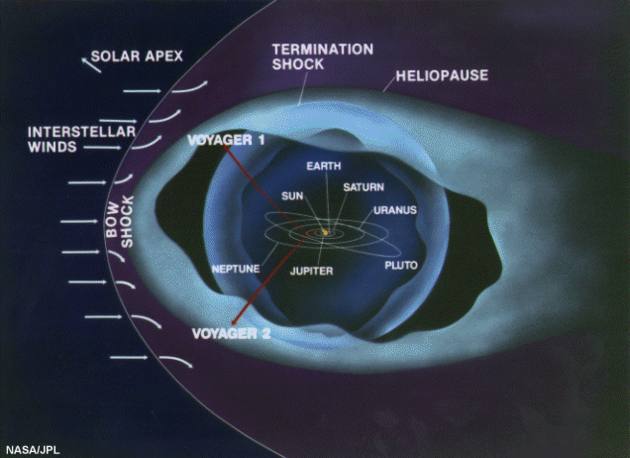Voyager 2 Detects Odd Shape of Solar System's Edge

Voyager 2 could pass beyond the outermost layer of our solar system, called the "termination shock," sometime within the next year, NASA scientists announced at a media teleconference today.
The milestone, which comes about a year after Voyager 1's crossing, comes earlier than expected and suggests to scientists that the edge of the shock is about one billion miles closer to the Sun in the southern region of the solar system than in the north.
This implies that the heliosphere, a spherical bubble of charged low-energy particles created by our Sun's solar wind, is irregularly shaped, bulging in the northern hemisphere and pressed inward in the south.
Scientists determined that Voyager 1 was approaching the termination shock when it began detecting charged particles that were being pushed back toward the Sun by charged particles coming from outside our solar system. This occurred when Voyager 1 was about 85 AU from the Sun.
One AU is the distance between the Earth and the Sun, or 93 million miles.
In contrast, Voyager 2 began detecting returning particles while only 76 AU from the Sun.
"This tells us that the shock down where Voyager 2 is must be closer the sun than where Voyager 1 is," said Ed Stone, Voyager project scientist at the California Institute of Technology in Pasadena.
Breaking space news, the latest updates on rocket launches, skywatching events and more!
The researchers think that the heliosphere's asymmetry might be due to a weak interstellar magnetic field pressing inward on the southern hemisphere.
"The [magnetic] field is only 1/100,000 of the field on the Earth's surface, but it's over such a large area and pushing on such a faint gas that it can actually push the shock about a billion miles in," Stone explained.
Both Voyager spacecrafts were launched from Cape Canaveral Air Force Station in Florida: Voyager 2 headed out on Aug. 20, 1977, Voyager 1 on Sept. 5, 1977.
Currently, Voyager 1 is about 9.1 billion miles from the Sun and traveling at a speed of 3.6 A U per year while Voyager 2 is about 7.3 billion miles away and moving at about 3.3 AU per year.
- Top 10 Voyager Facts
- Voyager Probe Poised to Plunge into Interstellar Space
- Mystery: Is Voyager at Solar System's Edge?
- GALLERY: Voyager Images
Ker Than is a science writer and children's book author who joined Space.com as a Staff Writer from 2005 to 2007. Ker covered astronomy and human spaceflight while at Space.com, including space shuttle launches, and has authored three science books for kids about earthquakes, stars and black holes. Ker's work has also appeared in National Geographic, Nature News, New Scientist and Sky & Telescope, among others. He earned a bachelor's degree in biology from UC Irvine and a master's degree in science journalism from New York University. Ker is currently the Director of Science Communications at Stanford University.
